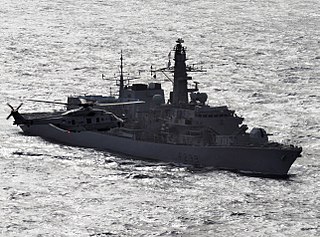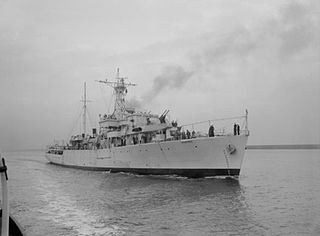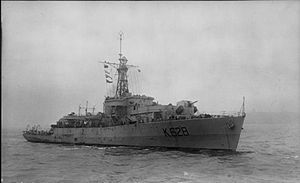
HMS Albion (R07) was a 22,000-ton Centaur-class light fleet carrier of the Royal Navy. The ship was laid down in 1944 and launched in 1947 but did not enter service until 1954. She served in the Royal Navy into the early 1970s.

HMS Montrose was the eighth of the sixteen-ship Type 23 or Duke class of frigates, of the Royal Navy, named after the Duke of Montrose. She was laid down in November 1989 by Yarrow Shipbuilders on the Clyde, and was launched on 31 July 1992 by Edith Rifkind, wife of Malcolm Rifkind, Secretary of State for Defence. She was commissioned into service in June 1994.

The sixth HMS Bulwark of the Royal Navy was a 22,000 ton Centaur-class light fleet aircraft carrier. Initially commissioned as a light aircraft carrier in 1954, the ship was converted into a commando carrier in 1958 and recommissioned as such in 1960. Bulwark remained in this capacity until 1979 following failed efforts to sell the ship, Bulwark re-entered service as an anti-submarine warfare carrier and remained as such until being decommissioned in 1981. The ship was scrapped in 1984.

HMS Iron Duke is a Type 23 frigate of the Royal Navy, and the third ship to bear the name.

HMS Richmond is a Type 23 frigate of the Royal Navy. She was launched on 6 April 1993 by Lady Hill-Norton, wife of the late Admiral of the Fleet The Lord Hill-Norton, and was the last warship to be built by Swan Hunter Shipbuilders. She sailed from the builders on the River Tyne in November 1994. She is named for the Dukedom of Richmond.

HMS Loch Fada was the lead ship of the Loch-class frigates of the British Royal Navy, built by John Brown & Company of Clydebank, Scotland, and named after Loch Fada in the Inner Hebrides.

HMS Loch Insh was a Loch-class frigate of the Royal Navy, named after Loch Insh in Scotland. She was built by Henry Robb of Leith and launched on 10 May 1944. After service at the end of World War II she was decommissioned, but reactivated in 1950 and served, mostly in the Persian Gulf, until 1962. The ship was sold to the Royal Malaysian Navy in 1963 and renamed KD Hang Tuah (F433). She was scrapped in 1977.

HMS Loch Lomond was a Loch-class frigate of the British Royal Navy. The ship was named after Loch Lomond in Scotland.

HMS Morecambe Bay was a Bay-class anti-aircraft frigate of the British Royal Navy, named after Morecambe Bay on the north western coast of England. In commission from 1949 until 1956, she saw active service in the Korean War, and was sold to Portugal in 1961 to serve as NRP Dom Francisco de Almeida until 1970.

HMS Cardigan Bay was a Bay-class anti-aircraft frigate of the British Royal Navy, named after Cardigan Bay, off the coast of Ceredigion, Wales.
HMS St Austell Bay was a Bay-class anti-aircraft frigate of the British Royal Navy, named after St Austell Bay on the south coast of Cornwall. In commission from 1945 until 1956, she served in the Mediterranean Fleet and on the America and West Indies Squadron.
HMS St Brides Bay was a Bay-class anti-aircraft frigate of the British Royal Navy, named for St Brides Bay in Pembrokeshire. In commission from 1945 to 1961, she served in the Mediterranean and Eastern Fleets, seeing active service in the Korean War.
HMS Start Bay (K604/F604) was a Bay-class anti-aircraft frigate of the British Royal Navy, named for Start Bay in Devon. In commission from 1945 to 1946 in the Mediterranean Fleet, she spent most of her career in the Reserve Fleet.

HMS Whitesand Bay was a Bay-class anti-aircraft frigate of the British Royal Navy, named for Whitesand Bay in Cornwall. In commission from 1945 to 1954, she served in the Pacific, Mediterranean, West Indies and Far East Fleets, seeing active service in the Korean War.

HMS Surprise was a Bay-class anti-aircraft frigate of the British Royal Navy. In commission from 1946 to 1965, she served in the Mediterranean Fleet as a Despatch Vessel for the Commander-in-Chief. Although principally employed for the use as a yacht by the CinC, Surprise was also deployed in its operational role as an anti-aircraft frigate and was allocated to the Haifa Patrol for a brief period in 1948. The archaic term "Despatch Vessel" was replaced by "Flag Frigate" in 1961.
HMS Dampier was a survey ship of the Royal Navy, named after the explorer, author and privateer, William Dampier (1652–1715). Originally intended as a Bay-class anti-aircraft frigate, the ship was in commission from 1948 to 1968, spending her entire career based at Singapore, carrying out survey work.

HMS Loch Fyne was a Loch-class frigate of the British Royal Navy, built by the Burntisland Shipbuilding Company Ltd, Burntisland, Fife, Scotland, and named after Loch Fyne in Scotland. The ship was launched in 1944, and served at the end of World War II. Recommissioned in 1951, she served in the Persian Gulf and was scrapped in 1970.

HMNZS Rotoiti (F625) was a Loch-class frigate of the Royal New Zealand Navy (RNZN), which had formerly served in the British Royal Navy as HMS Loch Katrine at the end of World War II.

HMS Loch Achray was a Loch-class frigate of the Royal Navy. She was built by Smith's Dock Co. Ltd. in South Bank-on-Tees and launched on 7 July 1944. After service in World War II, she was sold to the Royal New Zealand Navy and renamed HMNZS Kaniere (F426) in September 1948. After service in the Korean War, she was used as a training ship from 1957. She was sold in 1966 for breaking up in Hong Kong.

HMS Loch Achanalt was a Loch-class frigate of the Royal Navy that was loaned to and served with the Royal Canadian Navy during World War II. Ordered from Henry Robb, Leith, on 24 July 1942 as a River-class frigate, the order was changed, and ship laid down on 14 September 1943, and launched by Mrs. A.V. Alexander, wife of the First Lord of the Admiralty on 23 March 1944 and completed on 11 August 1944. After the war she was transferred to the Royal New Zealand Navy and renamed Pukaki.


















